 Technology peripherals
Technology peripherals
 AI
AI
 Fudan University team releases Chinese medical and health personal assistant, while open source 470,000 high-quality data sets
Fudan University team releases Chinese medical and health personal assistant, while open source 470,000 high-quality data sets
Fudan University team releases Chinese medical and health personal assistant, while open source 470,000 high-quality data sets
#With the rise of telemedicine, patients are increasingly inclined to choose online consultation and consultation to seek convenient and efficient medical support. Recently, large language models (LLM) have demonstrated powerful natural language interaction capabilities, bringing hope for health medical assistants to enter people's lives
Homepage address: https://med.fudan-disc.com Github address: https://github.com/FudanDISC/DISC-MedLLM Technical report: https://arxiv.org/abs/2308.14346
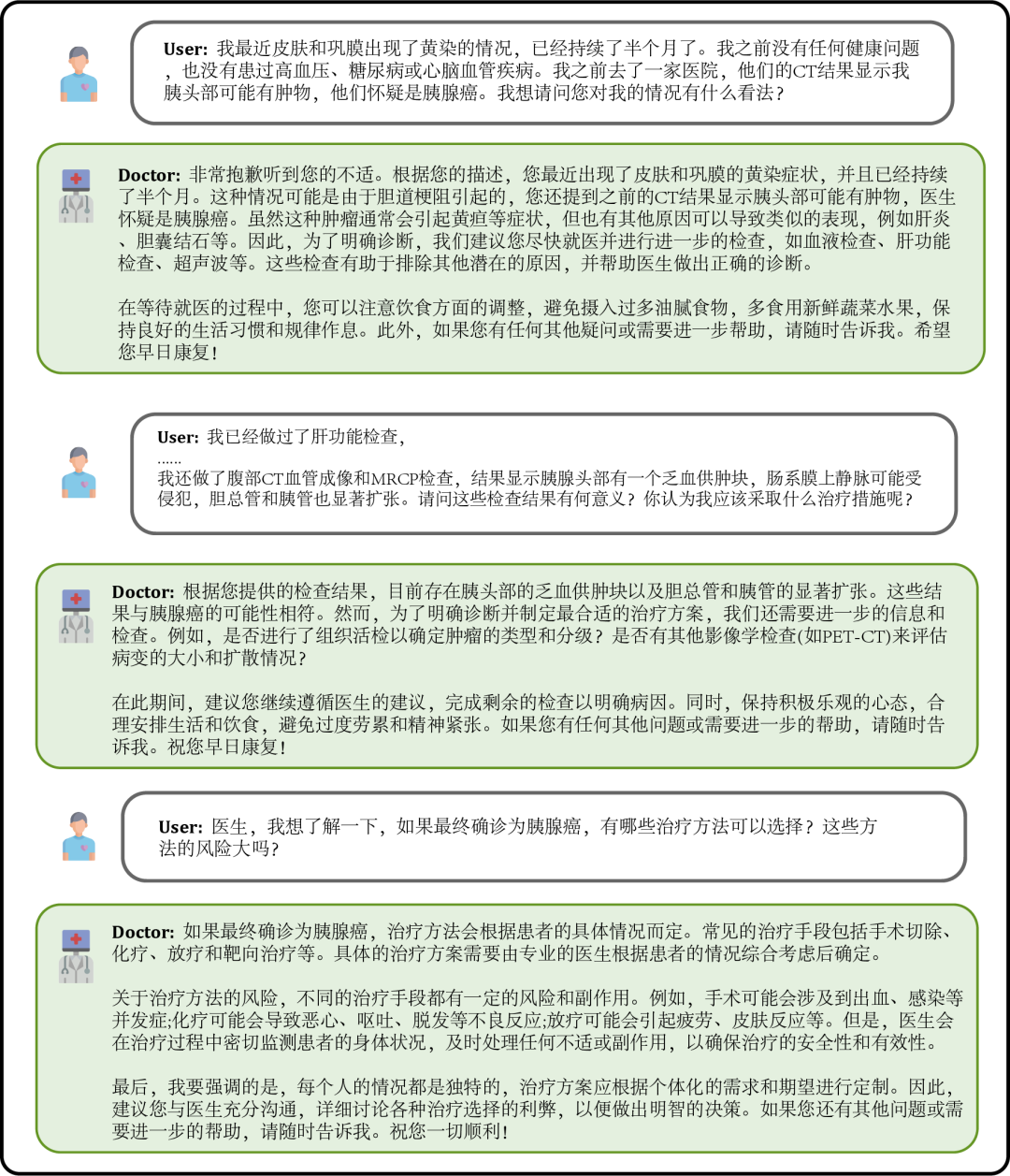


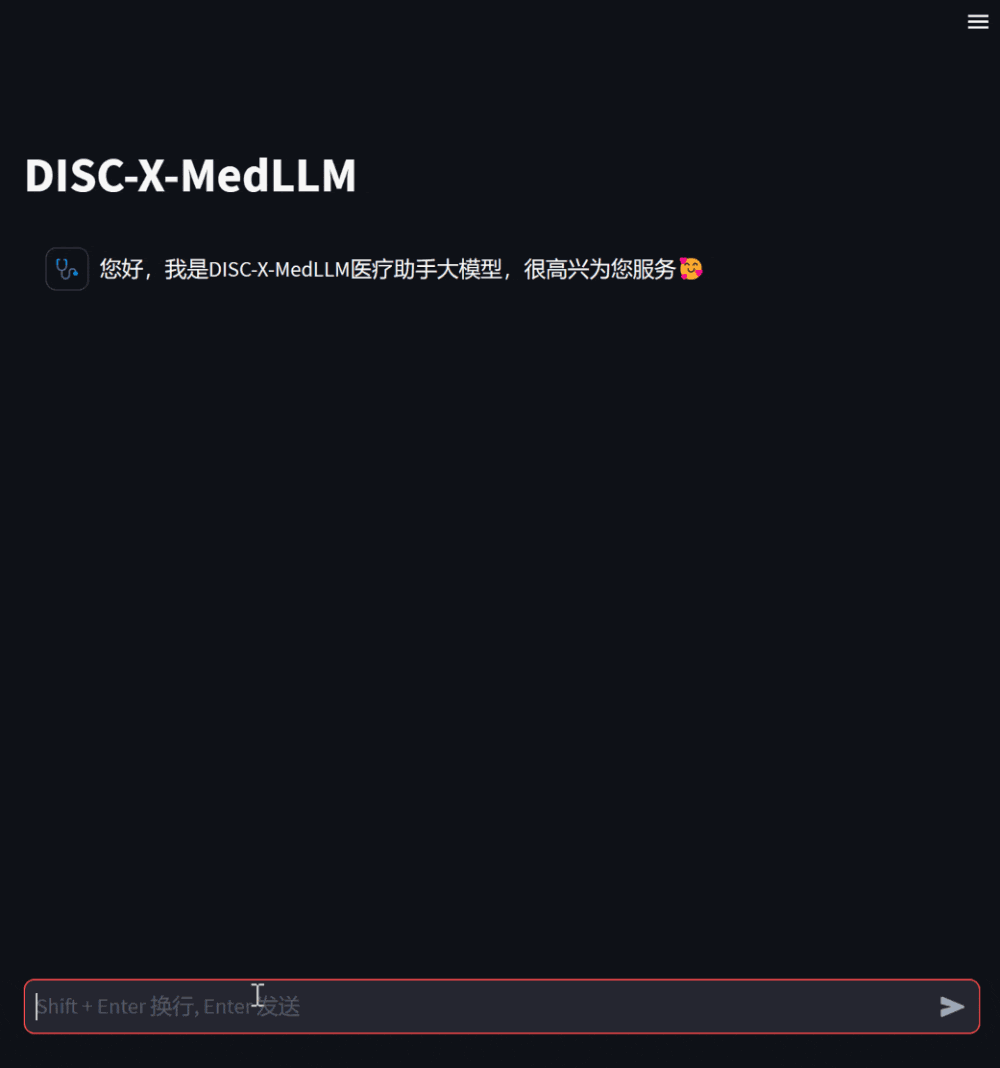
Reliable and rich expertise . We use the medical knowledge graph as the information source, sample triples, and use the language capabilities of the general large model to construct dialogue samples. Inquiry ability for multiple rounds of dialogue. We use real consultation dialogue records as the information source and use large models to reconstruct the dialogue. During the construction process, the model is required to completely align the medical information in the dialogue. Align responses to human preferences. Patients hope to obtain richer supporting information and background knowledge during the consultation process, but human doctors' answers are often concise; through manual screening, we construct high-quality, small-scale instruction samples to align with patients' needs.
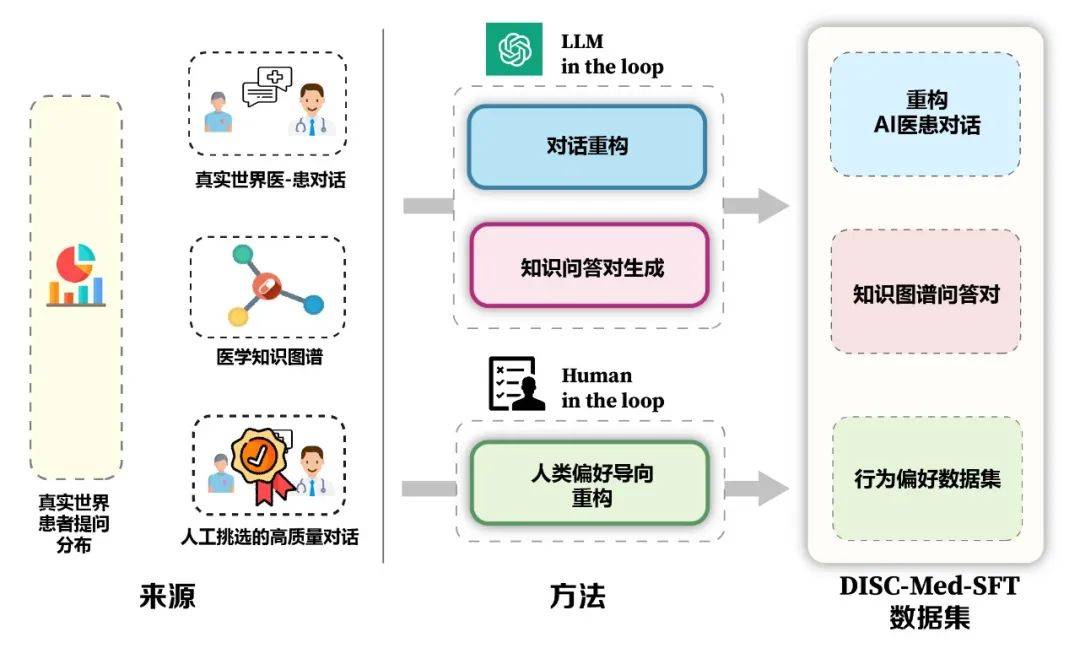
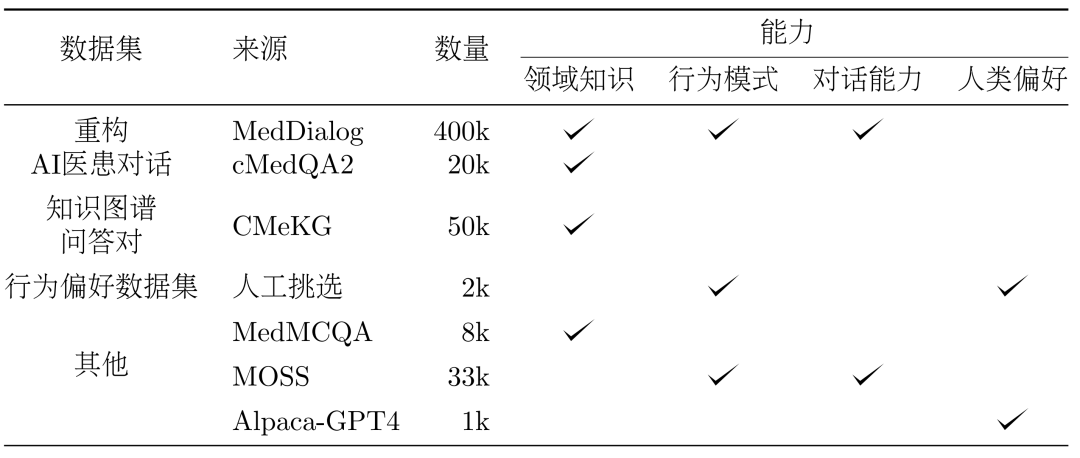
data set. 400,000 and 20,000 samples were randomly selected from two public data sets, MedDialog and cMedQA2, respectively, as source samples for SFT data set construction.
Refactoring. In order to adjust the real-world doctor answers into the required high-quality uniformly formatted answers, we utilized GPT-3.5 to complete the reconstruction process of this dataset. Prompts require rewriting to follow the following principles:
- Remove verbal expressions, extract unified expressions, and correct inconsistencies in doctors’ language use place.
- Stick to the key information in the original doctor's answer and provide appropriate explanations to be more thorough and logical.
- Rewrite or delete responses that AI doctors should not send, such as asking patients to make an appointment.
# Figure 6 shows an example of refactoring. The adjusted doctor's answers are consistent with the identity of the AI medical assistant, adhering to the key information provided by the original doctor while providing richer and more comprehensive help to the patient.
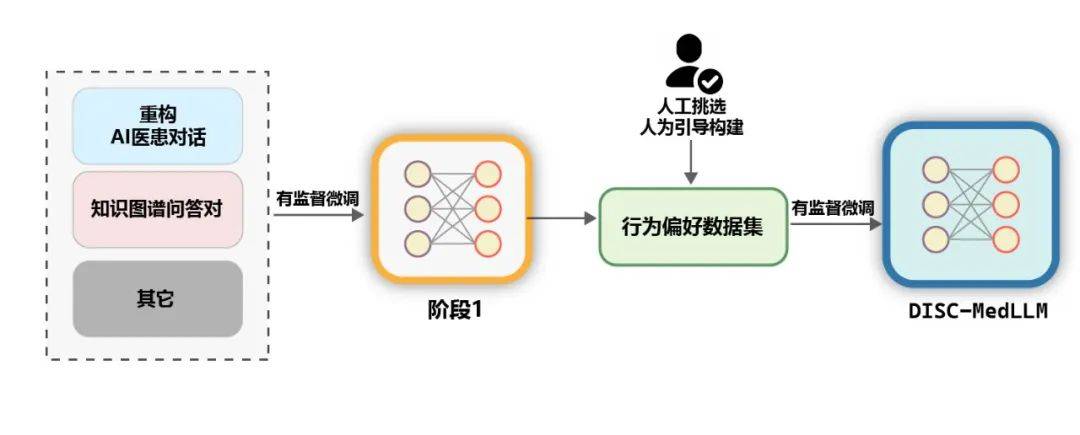
- Single-round QA evaluation: In order to evaluate the accuracy of the model in terms of medical knowledge, we collected data from the Chinese National Medical Licensing Examination (NMLEC) and The National Entrance Examination for Masters (NEEP) Western Medicine 306 major selected 1,500 multiple-choice questions to evaluate the performance of the model in a single round of QA.
- Multi-round dialogue evaluation: In order to systematically evaluate the dialogue ability of the model, we use three public data sets - Chinese Medical Benchmark Evaluation (CMB-Clin), Chinese Medical Dialogue Dataset (CMD) and Chinese Medical Intention Dataset (CMID), and GPT-3.5 randomly selects samples to play the role of patients and dialogue with the model. Four evaluation indicators are proposed - initiative, accuracy, usefulness and language quality. GPT-3.5 4 ratings.
Compare models. Our model is compared with three general LLMs and two Chinese medical conversational LLMs. Including OpenAI's GPT-3.5, GPT-4, Baichuan-13B-Chat; BianQue-2 and HuatuoGPT-13B.
Single round QA results. The overall results of the multiple-choice assessment are shown in Table 2. GPT-3.5 shows a clear lead. DISC-MedLLM achieved second place in the small-sample setting and ranked third behind Baichuan-13B-Chat in the zero-sample setting. Notably, we outperform HuatuoGPT (13B) trained with a reinforcement learning setting.

Results of multiple rounds of dialogue. In the CMB-Clin evaluation, DISC-MedLLM achieved the highest overall score, followed closely by HuatuoGPT. Our model scored highest in the positivity criterion, highlighting the effectiveness of our training approach that biases medical behavior patterns. The results are shown in Table 3.
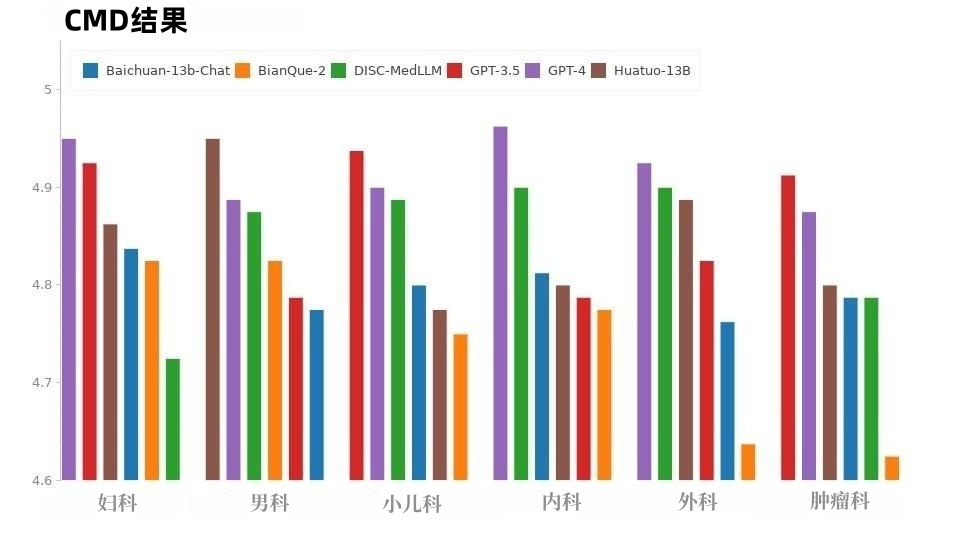
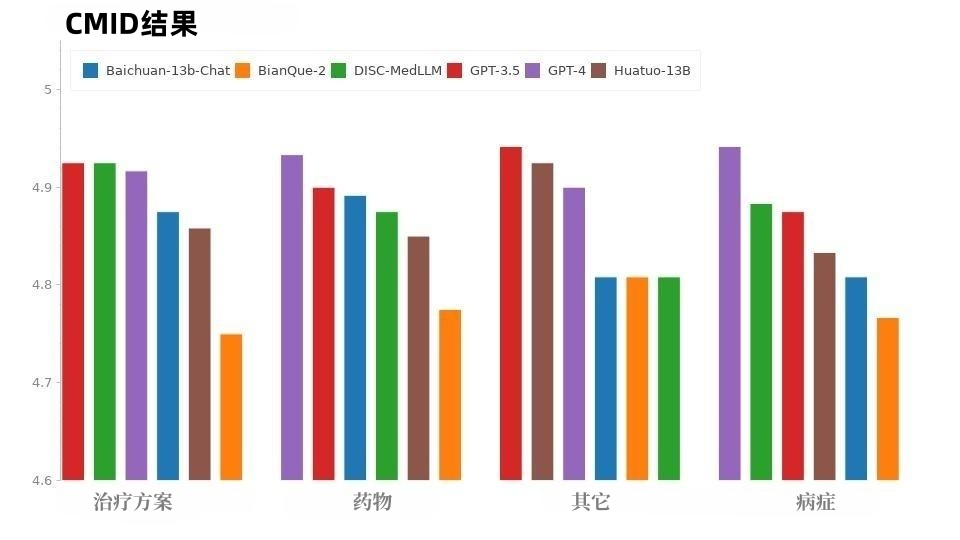
The above is the detailed content of Fudan University team releases Chinese medical and health personal assistant, while open source 470,000 high-quality data sets. For more information, please follow other related articles on the PHP Chinese website!

Hot AI Tools

Undresser.AI Undress
AI-powered app for creating realistic nude photos

AI Clothes Remover
Online AI tool for removing clothes from photos.

Undress AI Tool
Undress images for free

Clothoff.io
AI clothes remover

Video Face Swap
Swap faces in any video effortlessly with our completely free AI face swap tool!

Hot Article

Hot Tools

Notepad++7.3.1
Easy-to-use and free code editor

SublimeText3 Chinese version
Chinese version, very easy to use

Zend Studio 13.0.1
Powerful PHP integrated development environment

Dreamweaver CS6
Visual web development tools

SublimeText3 Mac version
God-level code editing software (SublimeText3)

Hot Topics
 1655
1655
 14
14
 1414
1414
 52
52
 1307
1307
 25
25
 1254
1254
 29
29
 1228
1228
 24
24
 Breaking through the boundaries of traditional defect detection, 'Defect Spectrum' achieves ultra-high-precision and rich semantic industrial defect detection for the first time.
Jul 26, 2024 pm 05:38 PM
Breaking through the boundaries of traditional defect detection, 'Defect Spectrum' achieves ultra-high-precision and rich semantic industrial defect detection for the first time.
Jul 26, 2024 pm 05:38 PM
In modern manufacturing, accurate defect detection is not only the key to ensuring product quality, but also the core of improving production efficiency. However, existing defect detection datasets often lack the accuracy and semantic richness required for practical applications, resulting in models unable to identify specific defect categories or locations. In order to solve this problem, a top research team composed of Hong Kong University of Science and Technology Guangzhou and Simou Technology innovatively developed the "DefectSpectrum" data set, which provides detailed and semantically rich large-scale annotation of industrial defects. As shown in Table 1, compared with other industrial data sets, the "DefectSpectrum" data set provides the most defect annotations (5438 defect samples) and the most detailed defect classification (125 defect categories
 NVIDIA dialogue model ChatQA has evolved to version 2.0, with the context length mentioned at 128K
Jul 26, 2024 am 08:40 AM
NVIDIA dialogue model ChatQA has evolved to version 2.0, with the context length mentioned at 128K
Jul 26, 2024 am 08:40 AM
The open LLM community is an era when a hundred flowers bloom and compete. You can see Llama-3-70B-Instruct, QWen2-72B-Instruct, Nemotron-4-340B-Instruct, Mixtral-8x22BInstruct-v0.1 and many other excellent performers. Model. However, compared with proprietary large models represented by GPT-4-Turbo, open models still have significant gaps in many fields. In addition to general models, some open models that specialize in key areas have been developed, such as DeepSeek-Coder-V2 for programming and mathematics, and InternVL for visual-language tasks.
 Training with millions of crystal data to solve the crystallographic phase problem, the deep learning method PhAI is published in Science
Aug 08, 2024 pm 09:22 PM
Training with millions of crystal data to solve the crystallographic phase problem, the deep learning method PhAI is published in Science
Aug 08, 2024 pm 09:22 PM
Editor |KX To this day, the structural detail and precision determined by crystallography, from simple metals to large membrane proteins, are unmatched by any other method. However, the biggest challenge, the so-called phase problem, remains retrieving phase information from experimentally determined amplitudes. Researchers at the University of Copenhagen in Denmark have developed a deep learning method called PhAI to solve crystal phase problems. A deep learning neural network trained using millions of artificial crystal structures and their corresponding synthetic diffraction data can generate accurate electron density maps. The study shows that this deep learning-based ab initio structural solution method can solve the phase problem at a resolution of only 2 Angstroms, which is equivalent to only 10% to 20% of the data available at atomic resolution, while traditional ab initio Calculation
 Google AI won the IMO Mathematical Olympiad silver medal, the mathematical reasoning model AlphaProof was launched, and reinforcement learning is so back
Jul 26, 2024 pm 02:40 PM
Google AI won the IMO Mathematical Olympiad silver medal, the mathematical reasoning model AlphaProof was launched, and reinforcement learning is so back
Jul 26, 2024 pm 02:40 PM
For AI, Mathematical Olympiad is no longer a problem. On Thursday, Google DeepMind's artificial intelligence completed a feat: using AI to solve the real question of this year's International Mathematical Olympiad IMO, and it was just one step away from winning the gold medal. The IMO competition that just ended last week had six questions involving algebra, combinatorics, geometry and number theory. The hybrid AI system proposed by Google got four questions right and scored 28 points, reaching the silver medal level. Earlier this month, UCLA tenured professor Terence Tao had just promoted the AI Mathematical Olympiad (AIMO Progress Award) with a million-dollar prize. Unexpectedly, the level of AI problem solving had improved to this level before July. Do the questions simultaneously on IMO. The most difficult thing to do correctly is IMO, which has the longest history, the largest scale, and the most negative
 PRO | Why are large models based on MoE more worthy of attention?
Aug 07, 2024 pm 07:08 PM
PRO | Why are large models based on MoE more worthy of attention?
Aug 07, 2024 pm 07:08 PM
In 2023, almost every field of AI is evolving at an unprecedented speed. At the same time, AI is constantly pushing the technological boundaries of key tracks such as embodied intelligence and autonomous driving. Under the multi-modal trend, will the situation of Transformer as the mainstream architecture of AI large models be shaken? Why has exploring large models based on MoE (Mixed of Experts) architecture become a new trend in the industry? Can Large Vision Models (LVM) become a new breakthrough in general vision? ...From the 2023 PRO member newsletter of this site released in the past six months, we have selected 10 special interpretations that provide in-depth analysis of technological trends and industrial changes in the above fields to help you achieve your goals in the new year. be prepared. This interpretation comes from Week50 2023
 To provide a new scientific and complex question answering benchmark and evaluation system for large models, UNSW, Argonne, University of Chicago and other institutions jointly launched the SciQAG framework
Jul 25, 2024 am 06:42 AM
To provide a new scientific and complex question answering benchmark and evaluation system for large models, UNSW, Argonne, University of Chicago and other institutions jointly launched the SciQAG framework
Jul 25, 2024 am 06:42 AM
Editor |ScienceAI Question Answering (QA) data set plays a vital role in promoting natural language processing (NLP) research. High-quality QA data sets can not only be used to fine-tune models, but also effectively evaluate the capabilities of large language models (LLM), especially the ability to understand and reason about scientific knowledge. Although there are currently many scientific QA data sets covering medicine, chemistry, biology and other fields, these data sets still have some shortcomings. First, the data form is relatively simple, most of which are multiple-choice questions. They are easy to evaluate, but limit the model's answer selection range and cannot fully test the model's ability to answer scientific questions. In contrast, open-ended Q&A
 The accuracy rate reaches 60.8%. Zhejiang University's chemical retrosynthesis prediction model based on Transformer was published in the Nature sub-journal
Aug 06, 2024 pm 07:34 PM
The accuracy rate reaches 60.8%. Zhejiang University's chemical retrosynthesis prediction model based on Transformer was published in the Nature sub-journal
Aug 06, 2024 pm 07:34 PM
Editor | KX Retrosynthesis is a critical task in drug discovery and organic synthesis, and AI is increasingly used to speed up the process. Existing AI methods have unsatisfactory performance and limited diversity. In practice, chemical reactions often cause local molecular changes, with considerable overlap between reactants and products. Inspired by this, Hou Tingjun's team at Zhejiang University proposed to redefine single-step retrosynthetic prediction as a molecular string editing task, iteratively refining the target molecular string to generate precursor compounds. And an editing-based retrosynthetic model EditRetro is proposed, which can achieve high-quality and diverse predictions. Extensive experiments show that the model achieves excellent performance on the standard benchmark data set USPTO-50 K, with a top-1 accuracy of 60.8%.
 Nature's point of view: The testing of artificial intelligence in medicine is in chaos. What should be done?
Aug 22, 2024 pm 04:37 PM
Nature's point of view: The testing of artificial intelligence in medicine is in chaos. What should be done?
Aug 22, 2024 pm 04:37 PM
Editor | ScienceAI Based on limited clinical data, hundreds of medical algorithms have been approved. Scientists are debating who should test the tools and how best to do so. Devin Singh witnessed a pediatric patient in the emergency room suffer cardiac arrest while waiting for treatment for a long time, which prompted him to explore the application of AI to shorten wait times. Using triage data from SickKids emergency rooms, Singh and colleagues built a series of AI models that provide potential diagnoses and recommend tests. One study showed that these models can speed up doctor visits by 22.3%, speeding up the processing of results by nearly 3 hours per patient requiring a medical test. However, the success of artificial intelligence algorithms in research only verifies this



